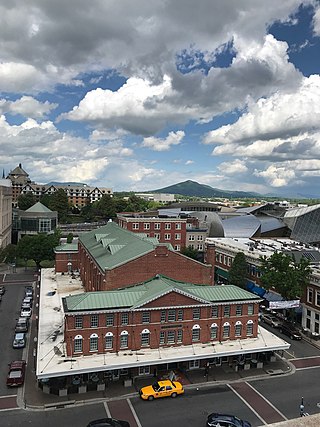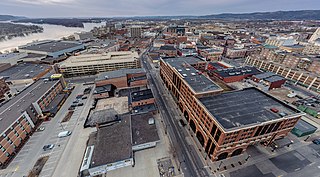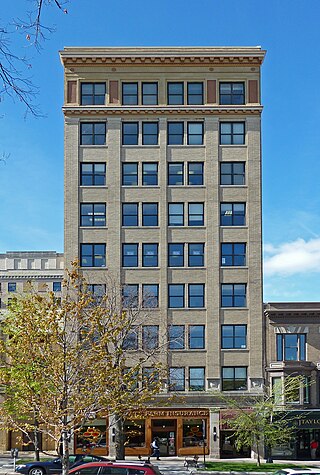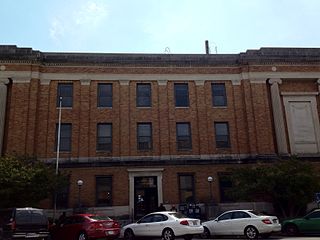
Marr & Holman was an architectural firm in Nashville, Tennessee known for their traditional design. Notable buildings include the Nashville Post Office and the Milliken Memorial Community House in Elkton, Kentucky.

Crescent Hill is a neighborhood four miles (6 km) east of downtown Louisville, Kentucky USA. This area was originally called "Beargrass" because it sits on a ridge between two forks of Beargrass Creek. The boundaries of Crescent Hill are N Ewing Ave to the St. Matthews city limit by Brownsboro Road to Lexington Road. Frankfort Avenue generally bisects the neighborhood.

The Historic Third Ward is a historic warehouse district located in downtown Milwaukee, Wisconsin. This Milwaukee neighborhood is listed on the National Register of Historic Places. Today, the Third Ward is home to over 450 businesses and maintains a strong position within the retail and professional service community in Milwaukee as a showcase of a mixed-use district. The neighborhood's renaissance is anchored by many specialty shops, restaurants, art galleries and theatre groups, creative businesses and condos. It is home to the Milwaukee Institute of Art and Design (MIAD), and the Broadway Theatre Center. The Ward is adjacent to the Henry Maier Festival Park, home to Summerfest. The neighborhood is bounded by the Milwaukee River to the west and south, E. Clybourn Street to the north, and Lake Michigan to the east.

Roanoke City Market Historic District, also known as City Market District, is a national historic district located in the Downtown Roanoke area of Roanoke, Virginia.

There are nine historic districts in Meridian, Mississippi. Each of these districts is listed on the National Register of Historic Places. One district, Meridian Downtown Historic District, is a combination of two older districts, Meridian Urban Center Historic District and Union Station Historic District. Many architectural styles are present in the districts, most from the late 19th century and early 20th century, including Queen Anne, Colonial Revival, Italianate, Art Deco, Late Victorian, and Bungalow.
Frank E. Wetherell was an American architect in the U.S. state of Iowa who was active from 1892 to 1931. He founded the second oldest architectural firm in the state in Des Moines, Iowa, in 1905. He worked with Roland Harrison in partnership Wetherell & Harrison. The firm designed numerous Masonic buildings.

Van Ryn & DeGelleke was an architectural firm in Wisconsin. It was a partnership of Henry J. Van Ryn and Gerrit Jacob DeGelleke, both of whom grew up in Milwaukee.

The Ridge Avenue Historic District in Galesville, Wisconsin is a 5 acres (2.0 ha) historic district which was added to the National Register of Historic Places in 1984. The district contains eleven contributing properties; they are primarily located on Ridge Avenue between 4th and 6th Streets. The district was added for its architectural importance; it features buildings with Italian, Queen Anne, and other architectural styles dated between 1859 and 1934. The John F. Cance House is located near the district at 807 West Ridge Avenue.

Downtown LaPorte Historic District is a national historic district located at LaPorte, LaPorte County, Indiana. The district encompasses 70 contributing buildings in the central business district of LaPorte. It developed between about 1860 and 1930, and includes examples of Queen Anne, Romanesque Revival, and Neoclassical style architecture. Notable buildings include the Zahrt Blocks, Ridgway Hotel (1863), Higday and Collins Blocks (1886–1888), LaPorte County Courthouse (1890–1894), Odd Fellows Building (1895), Lonn's Block (1889), People's Bank (1912), U.S. Post Office (1912), New York Central Depot (1909), Masonic Temple (1910), and Hotel Rumely (1912).

The La Crosse Commercial Historic District is located in downtown La Crosse, Wisconsin. It includes over ninety contributing structures, mostly 2-3 story commercial brick buildings constructed from the 1860s to the 1940s. The district is roughly bounded by Jay Street, Second Street South, State Street, and Fifth Avenue South.

Law, Law & Potter was an architecture firm in Madison, Wisconsin; Potter Lawson, Inc. is its modern-day successor. Some of its buildings are listed on the U.S. National Register of Historic Places for their architecture. The firm was Madison's largest and "arguably most important" architectural firm in the 1920s and 1930s.

The Middlesboro Downtown Commercial District in Middlesboro, Kentucky is a 37 acres (15 ha) historic district which was listed on the National Register of Historic Places in 1983.

The Louisiana Street/Seventh Avenue Historic District is located in Sturgeon Bay, Wisconsin. It was listed on the National Register of Historic Places in 1983 and on the State Register of Historic Places in 1989.

The Monroe Commercial District in Monroe, Wisconsin is a 31.2 acres (12.6 ha) historic district which was listed on the National Register of Historic Places in 1982.

The Exchange Square Historic District is a commercial historic district in downtown Brodhead, Wisconsin. The district contains thirty-eight buildings, thirty-five of which are considered contributing buildings to its historic character. Brodhead was platted as a railroad town in 1856 by the Milwaukee and Mississippi Railroad, and the oldest building in the district, the Farmer's Hotel, was completed the same year. The original railroad depot burned down, but its 1885 replacement still stands and is included in the district. Both Brodhead and its commercial district grew steadily through the late nineteenth and early twentieth centuries; every contributing building was completed by 1930. The district includes several examples of the Italianate and Queen Anne architectural styles, which were popular in the late nineteenth century, as well as many vernacular commercial buildings.

The Pleasant Hill Residential Historic District is a largely intact old neighborhood a few blocks east of Marshfield's downtown. Most of the contributing properties in the district were built between 1880 and 1949, including large, stylish homes built by businessmen and professionals, and smaller vernacular homes built by laborers. The district was placed on the National Register of Historic Places in 2000 for its concentration of intact historical architecture.

The Old World Third Street Historic District is the last relatively intact part of the original German retail district in Milwaukee, Wisconsin's Kilbourntown plat, containing examples of various styles of Victorian commercial architecture going back to 1855. It was listed on the National Register of Historic Places in 1987 and on the State Register of Historic Places in 1989.

The Downtown Bessemer Historic District, in Bessemer, Alabama, is a historic district which was listed on the National Register of Historic Places in 1992. The listing included 70 contributing buildings on 26 acres (11 ha).

Cathedral Historic District, originally the Sioux Falls Historic District, is located in Sioux Falls, South Dakota. Named for its centerpiece and key contributing property, the Cathedral of Saint Joseph, the district covers the neighbourhood historically known as Nob Hill, where multiple prominent pioneers, politicians, and businessmen settled in the late 19th and early 20th centuries. These homes primarily reflect Queen Anne and Mediterranean Revival architectural styles. In 1974, the neighborhood was listed as a historic district on the National Register of Historic Places (NRHP); at the time of this listing, there were 223 buildings, not all contributing, within the district's boundaries. The district was enlarged in 2023.




















